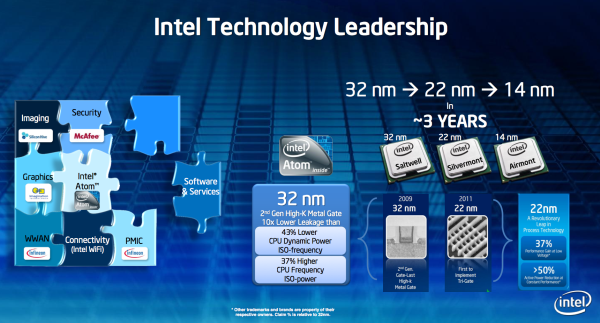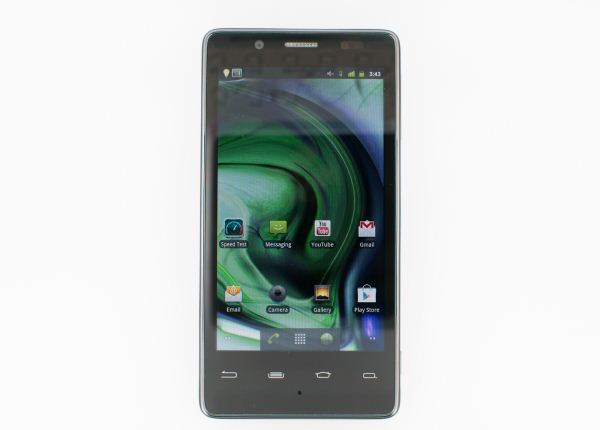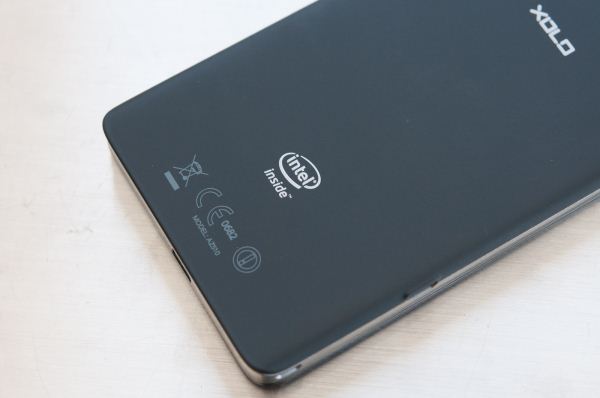Lava Xolo X900 Review - The First Intel Medfield Phone
by Brian Klug on April 25, 2012 6:00 AM ESTFor Intel, answering the looming ARM threat is obviously hugely important for the future, and it recognizes that - look no further than the restructuring of the Intel Architecture Group. The fire was lit with the impending arrival of Windows On ARM (WOA), at which point the line between traditional ARM-dominated smartphone/tablet SoCs and a real desktop class compute platform will start getting blurry, fast.
The other trend in the SoC space is slowly arranging all the pieces of the puzzle to truly deliver a complete System On Chip. In addition to CPU, GPU, and video encode/decode, those who will be the most successful and emerge as dominant players in the SoC space will need to bring baseband, GNSS, bluetooth, WLAN, and RF all onboard. Almost everyone gets that trend - Nvidia is adding baseband with Icera, Qualcomm has baseband and has added WLAN and Bluetooth with Atheros, Intel added baseband with Infineon and ISP with SiliconHive. Further, it has Gen graphics in the future for both GPU and video encode/decode. Look no further than the last slide of one of its slide decks and you'll see an illustration showing precisely what I'm talking about - pieces of the puzzle coming together.
We understand the motivation for building a smartphone SoC (computing is going even more mobile) and the integration necessary to get there (Intel owns a lot of IP blocks + Moore's Law), so how did Intel's first attempt fare? In short, reasonably well.
The Atom Z2460 in the X900 is a competent dual-core Cortex A9 competitor with competitive battery life and power draw, and no doubt Z2580 (its dual core, SGX544MP2 high end counterpart clearly targeted at Windows 8 platforms) will be equally as competitive against quad core A9s. If Intel's goal with both Medfield and the X900 was to establish a foothold in the smartphone SoC space and demonstrate that it can indeed deliver x86 in a smaller form factor and lower power profile than ever before then it truly is mission accomplished.
The x86 power myth is finally busted. While the X900 doesn't lead in battery life, it's competitive with the Galaxy S 2 and Galaxy Nexus. In terms of power efficiency, the phone is distinctly middle of the road - competitive with many of the OMAP 4 based devices on the market today. If you've been expecting the first x86 smartphone to end up at the bottom of every battery life chart, you'll be sorely disappointed.
There is however a big difference between middle of the road and industry leading, which is really the next step that we need to see from Intel. If Motorola is able to fit a 23% larger battery in a significantly thinner phone (Droid RAZR) then we need to see the same with Medfield. As Intel's major branded launch partner, we have high hopes that Motorola will deliver just that later this year.
The performance side is obviously even more competitive. Atom isn't always industry leading in our tests, but the X900 is rarely more than a couple places away from the top (with the exception of GPU performance of course, but that's a matter of licensing a different IP block in future versions). For a reference design that an Intel partner can just buy, barely customize, and ship - that's not bad at all. Smartphone vendors spend a considerable amount of time building phones that perform well - Intel's offer to internalize much of that can be either scary or amazing depending on who you're talking to.
There's always going to be room for design and software customization, but ultimately only those vendors who are good at those types of things will be able to survive if Intel's direct FFRD route succeeds. It's unsurprisingly very PC-like, where differentiation doesn't really happen at the motherboard level but rather at the system level. I can see both good and bad that could come of this, but the initial outcome should be positive. The results of this initial FFRD turned commercial device demonstrate that Intel is absolutely a competent system integrator itself, with an awesome display, camera, and other component choices.
The software compatibility story, like the concern over power consumption, is also a non-issue. The vast majority of apps we tried just worked, without any indication that we were running something intended for a different instruction set. There are still a few rough edges (e.g. Netflix), but if Intel is able to get things working this well at launch, the situation will only improve going forward.
Ultimately Intel's first smartphone is a foot in the door. It's what many said couldn't be done, and it's here now. What it isn't however is a flagship. To lead, Intel needs an updated Atom architecture, it needs to be on 22nm, and it needs a faster GPU - at a minimum. All of this needs to come in a reference design that's not just good enough, but better than the rest.
On the one hand it's a good thing that you can't tell an Intel smartphone apart from one running an ARM based SoC, on the other hand it does nothing to actually sell the Intel experience. Intel is never taken seriously in markets where it relies on being good enough, and it moves mountains in those where it's the best. That's what Intel needs to really build credibility in the smartphone space. A little was earned by getting this far, but its reputation will be made based on what happens next. There's obviously a strategy here, but I'm curious to see it unfold. Intel can be a fierce competitor in any space where it feels threatened. What I'm waiting for is that Conroe moment, but in a smartphone.
We waited years for Intel's first smartphone, now the question is how long do we have to wait for the first irresistable one?













106 Comments
View All Comments
Splynn - Sunday, April 29, 2012 - link
I'm curious as to if there will be cost saving in the software development side of a tablet or phone. Intel is very good at developing platforms at this point that have a consistency from a software point of view (for example, PCIe works like a super set of PCI from a software point of view which was a big factor in its adoption).If this saves enough on the cost of development and maintaining the software, then it would seem to be a good option. But it would be a new way of doing business for the embedded market.
djgandy - Wednesday, April 25, 2012 - link
Not a bad attempt, sure there are better SoC's out there but considering the age of the current Atom architecture and how it began it's not faring too badly. Medfield is a pretty old chip in terms of design. I'd expect Intel to start tick-tocking with Atom soonname99 - Thursday, April 26, 2012 - link
The whole POINT is that Intel probably can't spin this as fast as ARM can. That has always been the more intelligent argument against Intel in this space-not that x86 is too large or too power hungry, but that it is so so so much more painful to design and validate, but any attempt to cut corners has the potential for embarrassing bugs like the pentium FPU bug.therealnickdanger - Wednesday, April 25, 2012 - link
I wonder how much better this phone would do with ICS loaded instead of GB? Will AT give this phone an update when the official ROM is released?Please forgive my ignorance - you could load Windows XP or Windows 7 on this thing, correct? Dual boot? Is there hardware that would restrict one from doing so? Seems to me that if it's just a glorified X86 Atom, it could be done. Arguments about drivers, battery life, and overall functionality aside...
I'll keep watch over at XDA...
S20802 - Wednesday, April 25, 2012 - link
How would it be with Win7 SE? Pretty Cool for fun.Rick83 - Wednesday, April 25, 2012 - link
There might be some issues with Windows, as it probably expects some desktop hardware, such as PCI or PCIe buses.While the CPU is x86 (x64 supposedly), the systems is not necessarily what you'd call "PC-compatible".
Plus, the boot-loader is probably locked tightly.
It would be interesting to see how Windows 8 positions itself though. With the mobile version now being called Windows for ARM, I'm wondering if the normal version will run on the reduced platform that mobile Atom offers.
superPC - Wednesday, April 25, 2012 - link
Windows 8 can run on x86 SOC with LPDDR2 and no PCI/PCIe buses ( http://phil-it.org/chris/?p=1179 ). This phone can't run windows 8 though because it doesn't have any DirectX 9_3 compatible GPU. Now if anyone started selling phones with Z2580 (it uses PowerVR SGX544MP2 that can run DirectX 9_3) than it's all fair game (provided we can tinker with the BIOS and bootloader).IcePhase - Wednesday, April 25, 2012 - link
Doesn't Windows 8 also require a 768p screen?superPC - Wednesday, April 25, 2012 - link
yes if you want to run metro apps. if you only use the desktop than it's all good (tried this myself with HP mini note with the exact same resolution as this phone, pathetic i know...). for benchmarking though desktop is all we need. if you want to use it as a phone though than it's going to be tough (to say the least).superPC - Wednesday, April 25, 2012 - link
yes if you want to run metro apps. if you only use the desktop than it's all good (tried this myself with HP mini note with the exact same resolution as this phone, pathetic i know...). for benchmarking though desktop is all we need. if you want to use it as a phone though than it's going to be tough (to say the least).